8
PLANES, BRACES, BEVELS - Examples of hand tools used in local boat building.1940
Personal Collection, Halfmoon Bay, British Columbia, Canada
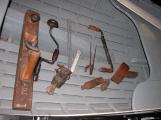
9
Shooting Plane: 22" long with 2 3/8" blade.The body of this plane is beech, carved to accommodate a blade, chip-breaker and frog combination (the metal parts) at the right angle to make long, straight cuts. The blade is sharpened straight across, so that the finished work is as "plane" and flat as possible. For much handtool construction, including furniture and cabinet work, this was the last tool to cut the surfaces that showed.
Brace - 15 1/2" long with 5" crank
This is a simple drilling brace for twist bits, with ball-bearing grips and a two-jaw chuck for holding tapered square shank bits.
Ink Line: 4 5/8" x 2 5/8" x 2 3/16"
Used to snap straight lines on log, timber or plank. Consists of a carved wooden body with a wooden crank operating a spool of linen line, which as it leads off the spool is held down into a charcoal and oil reservoir before exiting out a hole at the near end. The end of the line is secured to a sharpened jab-pin mounted in a wooden holder.
Adjustable Bevel: 8 5/8" short arm & 15 1/4" long arm. Just a larger than usual bevel for taking and transferring angles. Made from an old aluminum highway sign, stainless bolt, fender washers and a wingnut.
Dividers - 10" long. These lockable-angle dividers are used for scribing circles, spiling planks and otherwise transferring measurements.
Bucking Dolly and Setting Iron for clench nails and copper rivets - 8" long & 1 1/2" dia.
The dolly is used as a means of turning the flattened point of a boat nail (usually of galvanized iron) back into the steam-bent frame after it has been driven through both plank and frame. The narrower end is slightly dished to direct the tip of the nail. The tool can also be used to "buck" or back up the head of copper rivets when the other end of the rivet is being headed over with a ball-peen hammer.
The setting iron (6" long & 1 1/8" dia.) is drilled deep into one of its tapered ends, the other end having a slight depression to fit over the head of a rivet. The drilled end is used to back up the rove (a shallow conical washer that fits tight over the square shank of a rivet, usually on the frame side of a steamed-frame vessel) while the rivets are being driven home (set) from the outside of the hull. The rove grips the shank of the rivet, aiding in the final riveting performed with the ball-peen hammer. The dimpled end is used to buck the head while riveting.
Draw Knife - 16" long with 10 1/8" cutting edge.
This is used like a large spoke-shave, for carving oars, paddles and spars, chamfering rails, tapering stock, etc. Either deep or paring cuts can be taken, so it can be used for roughing-out or finishing. Cuts on the pull-stroke.
Wood-bodied Smoothing Plane - 9 3/8" long & 2" blade. Used for dressing surfaces that don't need to be dead-flat or finely finished. May be followed by the use of a jack-plane and shooting plane to achieve truly planar surfaces.
10
CHISELS, ADZE, AXE, SLICK - Examples of handtools used in local boat building.1930
Personal Collection, Halfmoon Bay, British Columbia, Canada
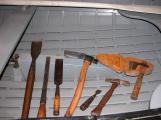
11
Slick: 28" long, 12 ¾" metal & 3" cutting edge.This is a type of chisel used for paring. The plane of the underside of the blade projects below the level of the handle, so that the handle doesn't impede the cutting action on a plane surface. It is not beaten with a mallet, but rather is used two-handed to smoothly slice shavings from (usually) broad surfaces such as the faying or mating surfaces of built-up timber structures (backbone members, frames etc.). The tool is heavy enough that its mass may also be used to jab, making it possible to remove quantities of wood quickly when roughing-out.
Mortising Chisel: 20 3/8" long, 15 ¼" metal & 1 1/8" cutting edge.
This is a socketed chisel with parallel sides and heavy, thick body, designed to cut mortices (slots) in timbers. It can be pounded when desired, and even pried on without shattering. The handle on this one is yew, with no banding, and has taken a considerable amount of pounding from wooden mallets with no sign of splitting. Like any other sharp chisel, it can be used for paring and precision cuts.
Framing Chisel: 15 7/8" long & 2" cutting edge.
Another socketed chisel, this one, manufactured by Greenlee, can be beaten on or can make fine paring cuts. The steel is both hard and tough, and weight is an advantage.
Gouging Adze: 9 ¼" long, 2 ¾" wide gouge & 18" handle.
For hollowing out, as in log canoe building. Two-handed use. 9 1/4 (236mm) head length; 2 3/4" (70mm) width of gouge.
Butt Chisel: 7" long & 1 1/8" cutting edge.
This short socketed chisel is used for close and detailed work. Generally one choses to use the largest chisel that will do the job, and this one is not large. Again, the handle is yew and has seen much "abuse" without breaking down. This is a favorite tool because of the fine steel.
Sculptor's Adze: 13 3/8" long, 6 5/8" head & 1 ½" cutting edge.
Of Italian manufacture, with a head of razor steel and handle of pear wood. It holds a fine, long-lasting edge. The gouge-shaped blade can be "dragged", cutting a long, controllable strip as it "snores" through the wood, either with the grain of the wood or across it. Uses: for coving planks, sculpting complex shapes in solid wood, adzing out depressions.
12
JAPANESE CARPENTER'S AXE - Examples of handtools used in local boat building.1980
Personal Collection, Halfmoon Bay, British Columbia, Canada
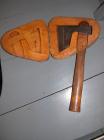
13
Japanese Carpenter's Axe: 13" long & 4 3/8" cutting edge.The head of this axe is thick right out to the cutting edge, which is beveled from both sides. The hand can be held right up behind the center of gravity and the center of effort due to the unique shape of the head, though that is not always the way it is used. The mass of the head being close to the cutting edge means that the blade is deflected less when chopping than would be the case with most western axes. Usually used one-handed for roughing out shapes like paddles and stems etc. Fine steel, handle of Japanese ash, scabbard of yellow cedar.
14
BUCKSAW - Example of handtools used in local boat building.1930
Sunshine Coast Museum & Archives, Gibsons, British Columbia, Canada
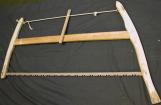
15
Buck Saw -Hubert Evans used this saw to cut planks from timber. A scaffolding was made to hold the log and the saw would be used by two people. One person would work from the top of the log and the other person would work from below. The person on the bottom got the sawdust.
16
HAND FORGE Example of handtools used in local boat building. See story 'Tools' for more info.1909
Sunshine Coast Museum & Archives, Gibsons, British Columbia, Canada
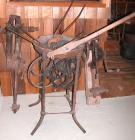
17
Forging Metal Fittings -Charcoal can be a substitute for coal, and produces a much hotter fire than fir bark. It does require a bit of preparation, however. One way to make quantities of charcoal (and you need lots for forge work, compared to coal, which is denser) is to build a hot fire of stove-wood-size alder, maple or other hardwood in a pit in the ground, load it up with wood, then smother the fire with earth before it has had a chance to burn the pile down. Actually you don't smother it completely at first, but allow a very little air in through vent holes punched into the earth covering. The idea is to keep the combustion going but starved for sufficient oxygen. The gases burn off and the wood becomes carbonized. Once smoke ceases to exit the vents, these are closed off too, thus starving the fire of air altogether and effectively putting it out. When cold, the earth can be removed and the charcoal separated from the remaining dirt by means of a coarse seive. If kept dry, this is a decent fuel for a hot enough fire to weld iron if desired. There are more complicated ways to make charcoal of course, burning less wood in the process, but for backyard production this is effective.
18
BELLOWS - Example of handtools used in local boat building.1909
Sunshine Coast Museum & Archives, Gibsons, British Columbia, Canada

19
True "wrought iron" was used by choice for marine fittings, being more resistant to corrosion than the steels. Wrought iron is manufactured by an ancient process in which the product has a considerable amount of sulphur mixed with the iron. The sulphur probably contributes to the durability of the material around sea water. Remains of Viking craft and other Europeanships attest to the lasting qualities of wrought iron. Now, when "iron" fittings are made, usually of what is really mild steel, hot dip galvanizing in zinc or special zinc-rich paint coatings are usually used to protect the surface of the metal.
The bronzes and brasses (copper alloyed with silica, zinc, tin, manganese etc) can be cast or machined from solid and sheet stock to make boat fittings, but around these parts many of the boat fittings that might be made from these materials were common chandlery or mail-order items.
20
POST MOUNTED DRILL PRESS - Example of handtools used in local boat building.1909
Sunshine Coast Museum & Archives, Gibsons, British Columbia, Canada
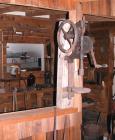
21
Nicol Warn explains his setup -"I really don't have much to show in the way of a metal-working facility; a couple of hammers, vice grip pliers, a nothing-fancy vice, some hunky old chunks of iron for beating things on, and a forge made of a truck brake-drum set in the ground, with an electric stove-fan blowing air up through a grating (tuyere) in the center. Plus a cutting torch and buzz-box welder. And a post-mounted drill press like the one you have in the museum, except it's been modified to be run off a 3/4 HP electric motor. Add a hacksaw and cold-chisels and there are lots of things one can make from scrap metal."